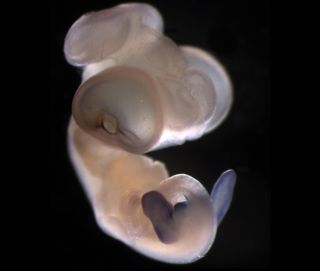Snakes Use 'Leg Genes' to Make Phalluses

Snakes lack limbs, but new research finds that they still have DNA crucial to limb development lurking in their genomes. So, why keep that genetic baggage around?
To build a penis, of course.
A new study, published today (Oct. 1) in the journal Developmental Cell, reveals that the same genetic snippets that control the outgrowth of limbs (called enhancers) during embryonic development in mammals are crucial to the development of the phallus in both mammals and reptiles — including legless snakes. (The embryonic phallus structure eventually becomes a penis in males and a clitoris in females.)
"It tells us that we are a little bit myopic in thinking about what these limb enhancers are doing in mammals," said study leader Doug Menke, a genetics researcher at the University of Georgia. "We've really been thinking of these as limb enhancers, but more broadly, these genetic components are actually also participating in development and driving gene expression in other body tissues," he told Live Science. [See Photos of Snake Embryos Developing a Phallus]
Missing legs
Menke and his team are interested in DNA components called cis-regulatory elements, or enhancers. Unlike DNA coding, these segments of genetic information don't provide the recipe for proteins. Instead, they're noncoding segments. Their job is to control how the protein-coding genes get turned on and off.
Hundreds of these segments are involved in the process of building limbs in utero, Menke said, referring to knowledge gained mostly through research in mice. The researchers wanted to gain a better understanding of how the limb enhancers contribute to the evolution of different sizes and shapes of limbs.
Sign up for the Live Science daily newsletter now
Get the world’s most fascinating discoveries delivered straight to your inbox.
"You can't get much more extreme than an animal that completely lacks limbs," Menke said. (Some snakes do have tiny vestigial hind limbs, leftovers from the days when snakes did have limbs more than 80 million years ago.)
The researchers first looked at the genomes of three snake species (boa constrictors, Burmese pythons and king cobras) and a reptile with legs, the Anolis lizard. They found a surprise.

"The number of these enhancers that we could detect in lizards versus snakes was very similar," Menke said. "By and large, if we could find a limb enhancer that was conserved between mammals and lizards, we could also find the same enhancer in a snake."
Limbs vs. penises
This finding was strange, because DNA is a "use it or lose it" sort of tool, Menke said. In the 80 million years since snakes lost their legs, the limb-enhancing DNA should have become a mess of random mutations. The fact that these sequences were intact suggested they might serve an important function, he said.
The researchers already knew that many mammalian limb enhancers are also active during embryonic development of the external genitalia. In the new study, Menke's team used mice to find that about half of gene segments dubbed limb enhancers are also active in phallus development. After all, both limbs and phalluses are outgrowths off the main body, Menke said, so it makes sense that they'd share genes to get the job done. [8 Wild Facts About the Penis]
When looking at the Anolis lizards, the researchers found limb enhancers also affected both hind limbs and genitals. Then, they took snake enhancer sequences and spliced them into the DNA of developing mouse embryos. They found that the snake DNA segments could no longer "turn on" the genes in the mouse back legs — but they could activate the genes in the mouse genital tract. In other words, Menke said, the snake's enhancer segments have specialized to become phallus-specific.
Evolution of the phallus
These findings matter in part because they expand scientists' knowledge of the evolution of external genitalia. The hypothesis, Menke said, is that ancient, limbless animals reused their leg genes to develop penises when internal fertilization developed. (The penis first showed up about 310 million years ago in evolution.) These findings mesh with that notion.

The research also has implications for humans. There are genetic disorders that result in limb and genital birth defects. One example is the rare hand-foot-genital syndrome, in which people have shortened thumbs and shortened big toes, abnormalities in the wrists and ankles, and defects in the urethra and sometimes in the uterus. That syndrome is the result of a mutation in a protein-coding gene, Menke said. The new research suggests that defects in noncoding limb enhancers might cause problems, too.
The next question, Menke said, is what makes the enhancers specialized for the limbs or the genitals. Are there differences in which proteins bind to these DNA segments? Or are the differences between limbs and genitals driven by differences in the DNA segments themselves?
"Some of the circuitry has to be different," Menke said. "The morphology and function of the phallus is very different from your legs."
Follow Stephanie Pappas on Twitter and Google+. Follow us @livescience, Facebook & Google+. Original article on Live Science.

Stephanie Pappas is a contributing writer for Live Science, covering topics ranging from geoscience to archaeology to the human brain and behavior. She was previously a senior writer for Live Science but is now a freelancer based in Denver, Colorado, and regularly contributes to Scientific American and The Monitor, the monthly magazine of the American Psychological Association. Stephanie received a bachelor's degree in psychology from the University of South Carolina and a graduate certificate in science communication from the University of California, Santa Cruz.
